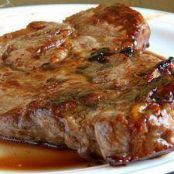Tuscan-Style Roast Pork with Garlic and Rosemary (Arista)
By á-141726
The Tuscan roast pork dish known as arista promises to turn lean, mild pork loin into a juicy roast flavored with plenty of garlic and rosemary and featuring a deeply browned crust. Yet most versions turn out dry and bland. To boost both flavor and juiciness, we salted the meat for 1 hour before cooking, using a double-butterfly technique to expose plenty of surface area and then salting both sides and rolling it back up. This technique also allowed us to maximize the distribution of the garlic and rosemary. Briefly simmering the herb-garlic mixture before spreading it over the pork tempered any raw flavors, and using plenty of oil (which we then strained off) and a nonstick skillet kept the garlic from browning, for a fresher garlic flavor. To boost richness and enhance the overall porky flavor, we processed pancetta with the garlic and rosemary (plus red pepper flakes and lemon zest for brightness) to make a paste. Using a low oven ensured that the meat was evenly cooked from edge to center. And to keep the crust crispy, instead of roasting, browning, and then resting the roast under foil, we let it rest after it came out of the oven and then browned it and served it immediately. For a finishing touch, we made a simple, bright, rich sauce by combining the reserved strained oil with the juice from a halved lemon that we quickly caramelized in the skillet for more complex flavor.
Ingredients
- 1 lemon
- 1/3 cup extra-virgin olive oil
- 8 garlic cloves, minced
- 1/4 teaspoon red pepper flakes
- 1 tablespoon chopped fresh rosemary
- 2 ounces pancetta, cut into 1/2-inch pieces
- 1 (2 1/2-pound) boneless center-cut pork loin roast, trimmed
- Kosher Salt
Details
Servings 4
Adapted from americastestkitchen.com
Preparation
Step 1
We strongly prefer natural pork in this recipe, but if enhanced pork (injected with a salt solution) is used, reduce the salt to 2 teaspoons (1 teaspoon per side) in step 3. After applying the seasonings, the pork needs to rest, refrigerated, for 1 hour before cooking.
1. Finely grate 1 teaspoon zest from lemon. Cut lemon in half and reserve. Combine lemon zest, oil, garlic, and pepper flakes in 10-inch nonstick skillet. Cook over medium-low heat, stirring frequently, until garlic is sizzling, about 3 minutes. Add rosemary and cook, 30 seconds. Strain mixture through fine-mesh strainer set over bowl, pushing on garlic-rosemary mixture to extract oil. Set oil aside and let garlic-rosemary mixture cool. Using paper towels, wipe out skillet.
2. Process pancetta in food processor until smooth paste forms, 20 to 30 seconds, scraping down sides of bowl as needed. Add garlic-rosemary mixture and continue to process until mixture is homogeneous, 20 to 30 seconds longer, scraping down sides of bowl as needed.
3. Position roast fat side up. Insert knife one-third of way up from bottom of roast along 1 long side and cut horizontally, stopping 1/2 inch before edge. Open up flap. Keeping knife parallel to cutting board, cut through thicker portion of roast about 1/2 inch from bottom of roast, keeping knife level with first cut and stopping about 1/2 inch before edge. Open up this flap. If uneven, cover with plastic wrap and use meat pounder to even out. Sprinkle 1 tablespoon kosher salt over both sides of roast (1/2 tablespoon per side) and rub into meat to adhere. Spread inside of roast evenly with pancetta-garlic paste, leaving about 1/4-inch border on all sides. Starting from short side, roll roast (keeping fat on outside) and tie with twine at 1-inch intervals. Set wire rack in rimmed baking sheet and spray with vegetable oil spray. Set roast fat side up on prepared rack and refrigerate for 1 hour.
4. Adjust oven rack to middle position and heat oven to 275 degrees. Transfer roast to oven and cook until meat registers 135 degrees, 1 1/2 to 2 hours. Remove roast from oven, tent with aluminum foil, and let rest for 20 minutes.
5. Heat 1 teaspoon reserved oil in now-empty skillet over high heat until just smoking. Add reserved lemon halves, cut side down, and cook until softened and cut surfaces are browned, 3 to 4 minutes. Transfer lemon halves to small plate.
6. Pat roast dry with paper towels. Heat 2 tablespoons reserved oil in now-empty skillet over high heat until just smoking. Brown roast on fat side and sides (do not brown bottom of roast), 4 to 6 minutes. Transfer roast to carving board and remove twine.
7. Once lemon halves are cool enough to handle, squeeze into fine-mesh strainer set over bowl. Press on solids to extract all pulp; discard solids. Whisk 2 tablespoons strained lemon juice into bowl with remaining reserved oil. Slice roast into 1/4-inch-thick slices and serve, passing vinaigrette separately.
For Better Taste, Cook the Paste
Most recipes call for applying raw garlic and rosemary to the pork before roasting, but this results in harsh flavors. By precooking our paste, we expose the garlic and rosemary to high temperatures and ensure that their flavors are mellowed.
Rest, Sear, and Serve
When developing our recipe for Tuscan-Style Roast Pork with Garlic and Rosemary (Arista), we found that most recipes call for letting the roast rest under foil after it’s been cooked through and browned and then serving it. This allows time for the internal juices to redistribute and for carryover cooking to bring the roast up to the final serving temperature. But covering a well-browned roast with foil will trap steam and cause the crust to soften. By letting it rest after cooking and then searing it and serving it immediately, we guarantee a perfectly crisp crust at the table.
You'll also love
-
 PINK LEMONADE VODKA SLUSH
0/5
(0 Votes)
PINK LEMONADE VODKA SLUSH
0/5
(0 Votes)
-
 Spinach and Cheese Crostini
0/5
(0 Votes)
Spinach and Cheese Crostini
0/5
(0 Votes)
-
 Ham, spinach & potato frittata
0/5
(0 Votes)
Ham, spinach & potato frittata
0/5
(0 Votes)
-
 Sausage Egg Roll in a Bowl
0/5
(0 Votes)
Sausage Egg Roll in a Bowl
0/5
(0 Votes)
-
 Bacon-Wrapped Pickles
0/5
(0 Votes)
Bacon-Wrapped Pickles
0/5
(0 Votes)
-
 Easy Honey Garlic Slow Cooker Ribs
1/5
(1 Votes)
Easy Honey Garlic Slow Cooker Ribs
1/5
(1 Votes)



Review this recipe